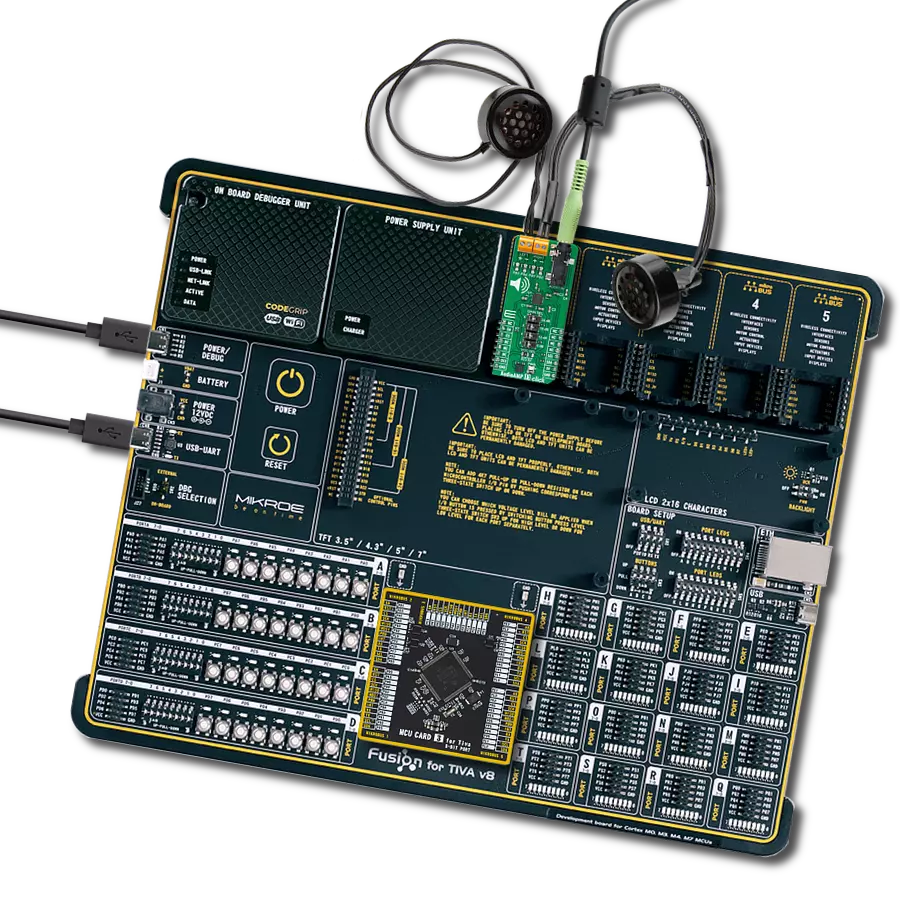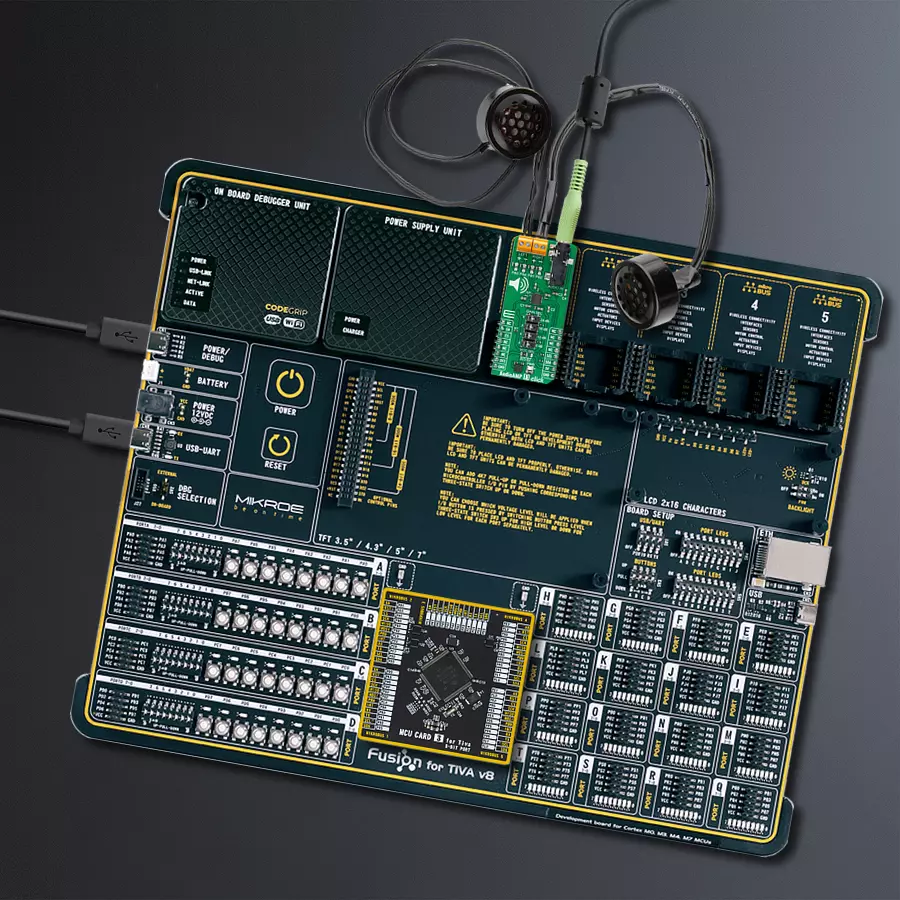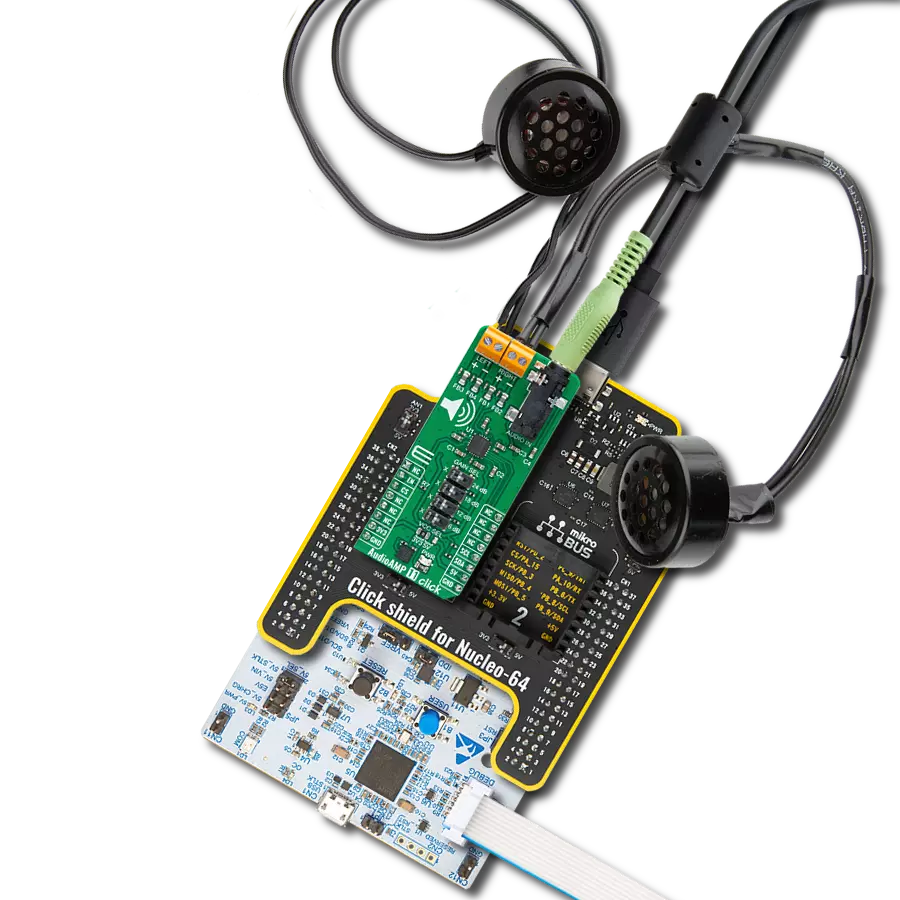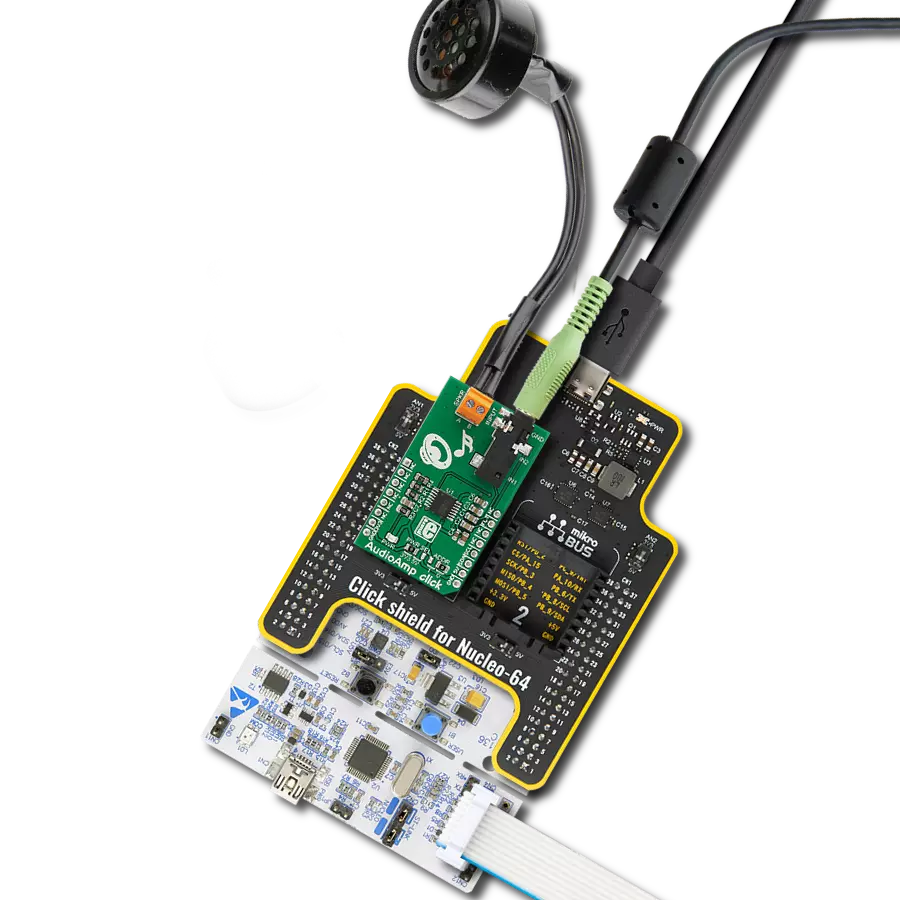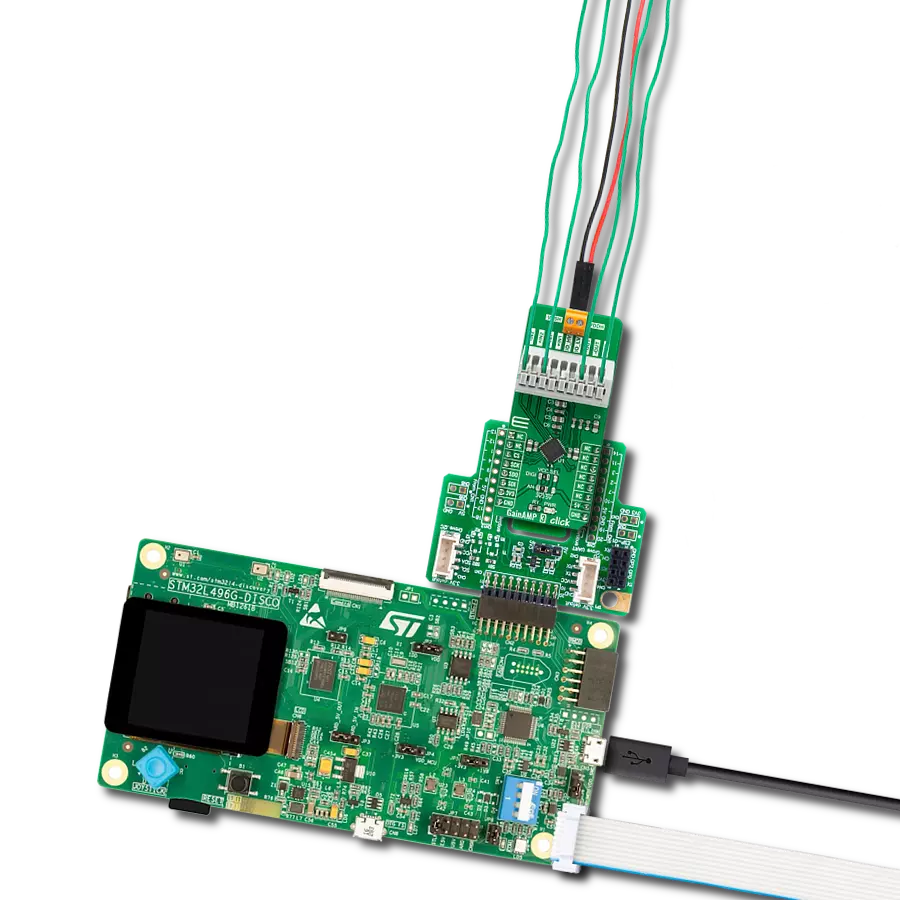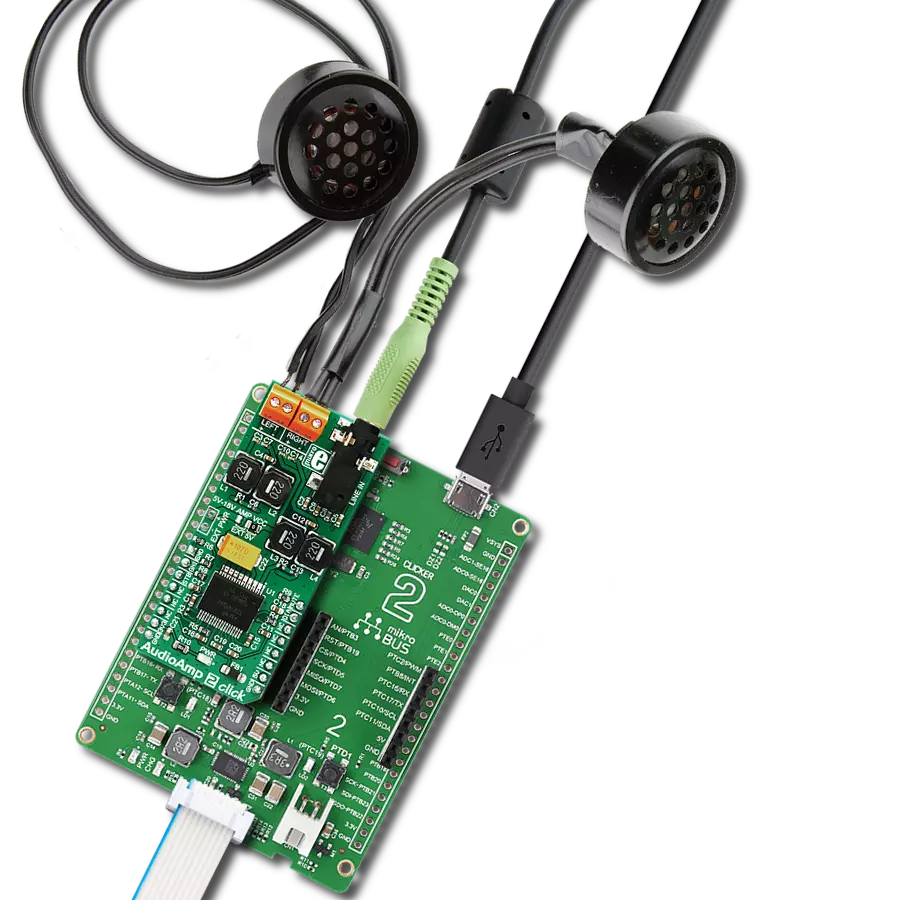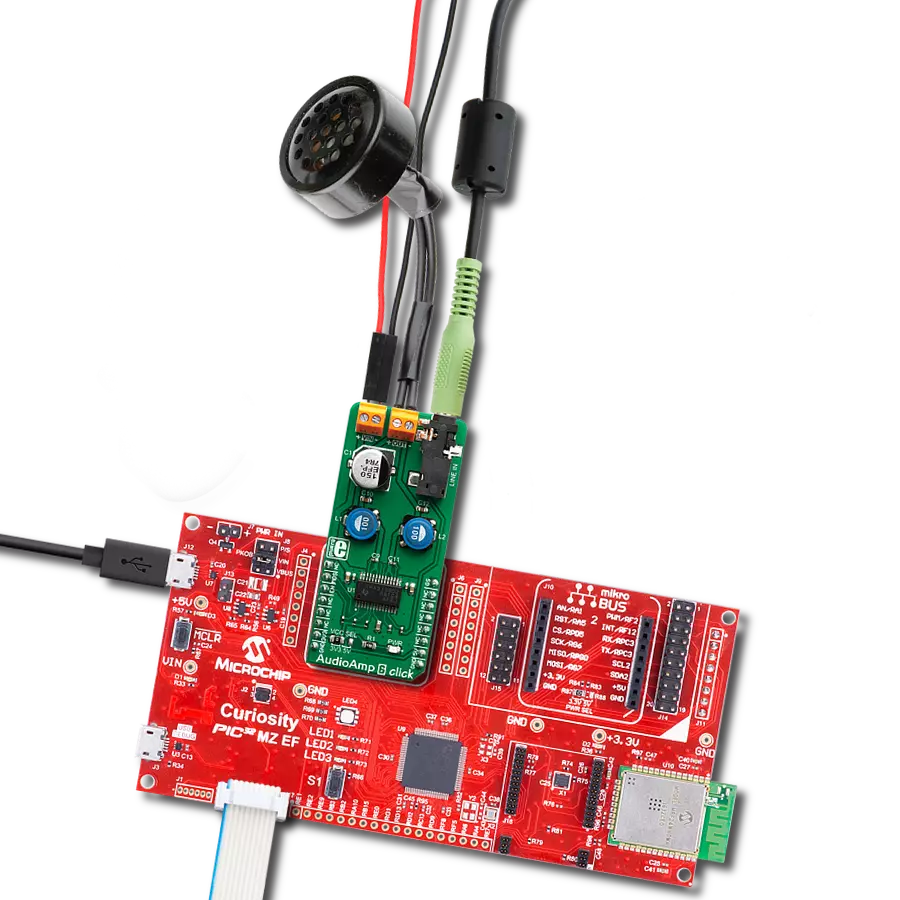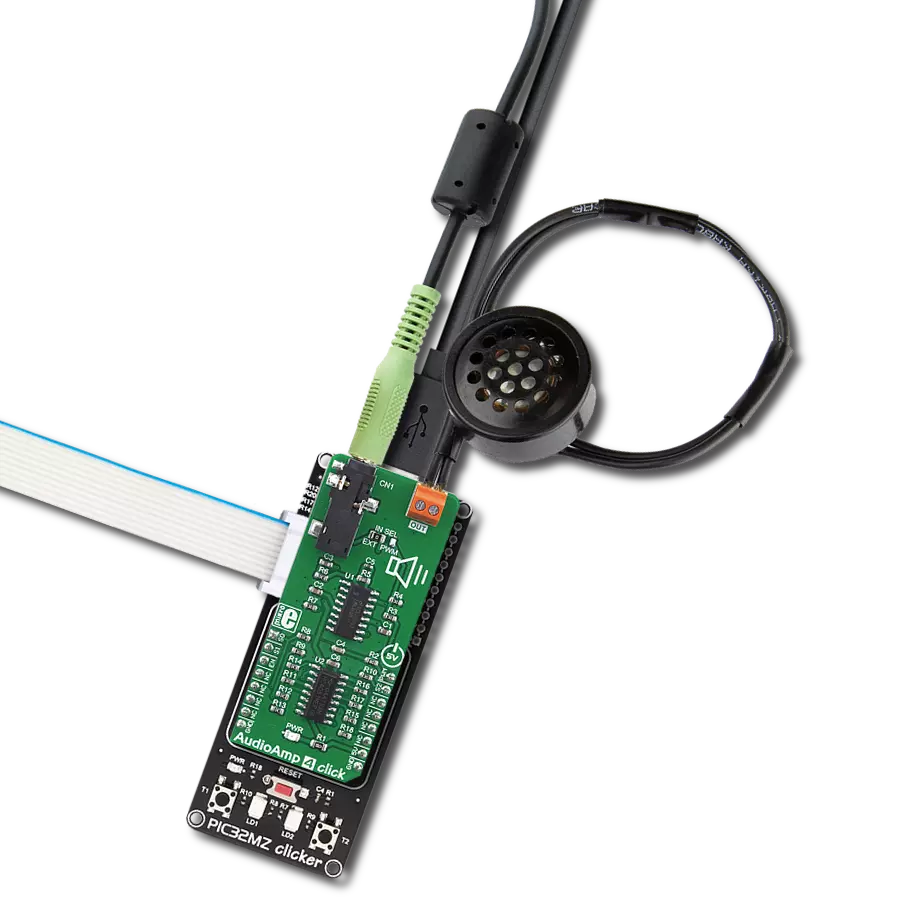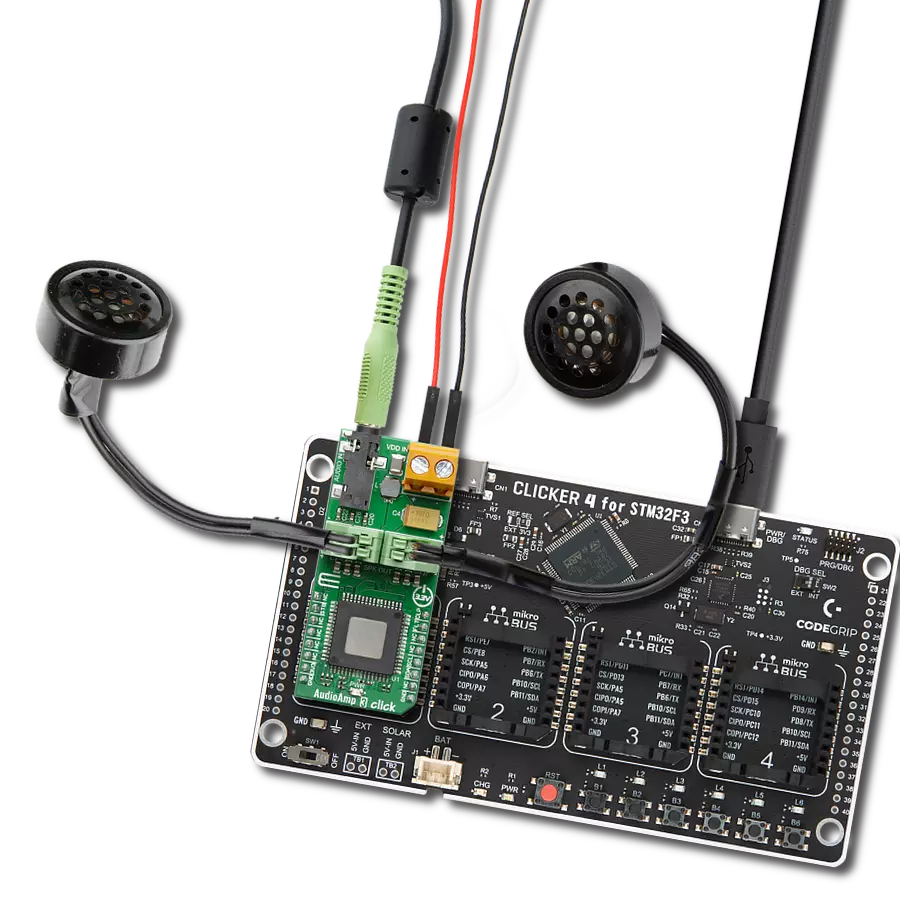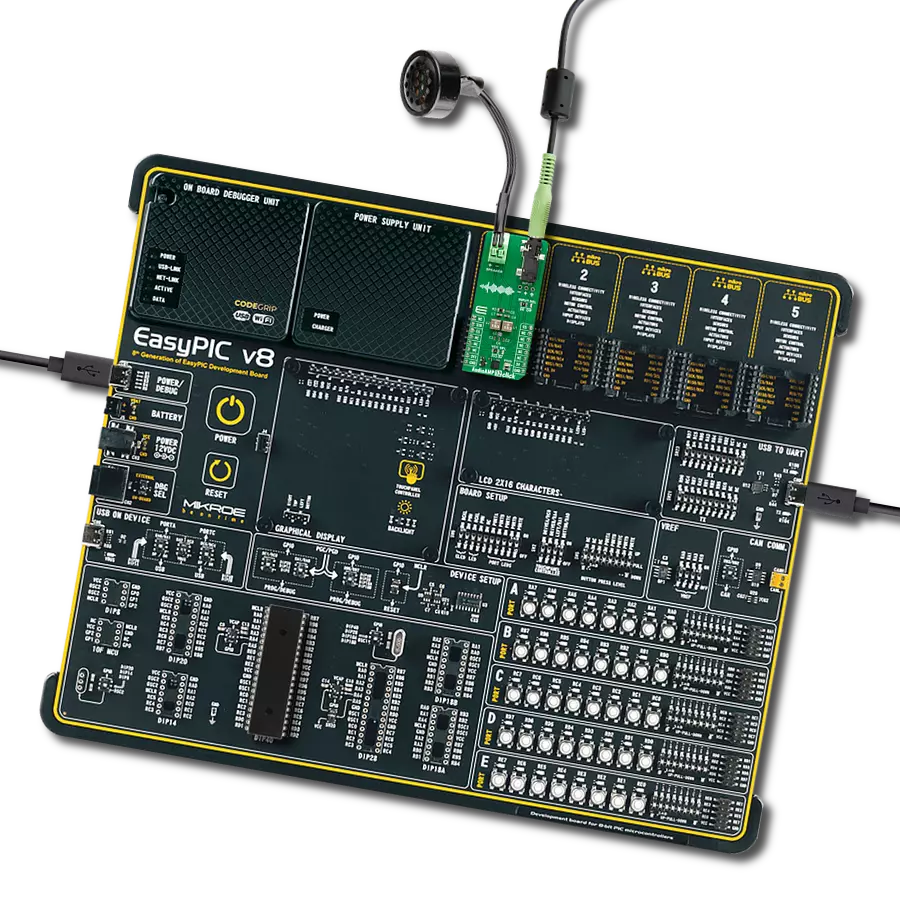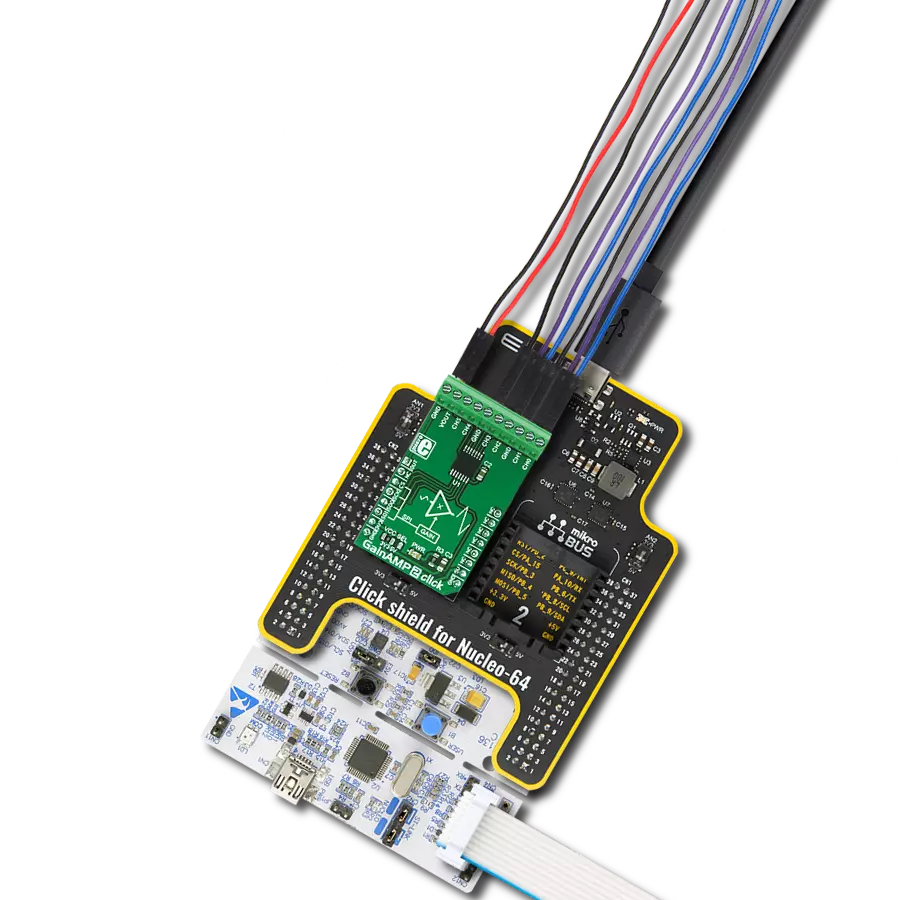Unleash the full potential of your audio with this compact and high-performance amplifier
A
A
Hardware Overview
How does it work?
AudioAMP 11 Click is based on the NAU8224, a stereo Class-D audio amplifier from Nuvoton Technology. Besides an excellent quantity performance, such as high efficiency, the NAU8224 is also characterized by high output power and low quiescent current. It can drive a 4Ω load with up to 3.1W output power. This audio amplifier is designed to reduce high-frequency emissions with the ferrite bead filters on its outputs (speaker channels). The ferrite beads have a low impedance in the audio range, and because of that, they act as a pass-through filter in the audio frequency range. Furthermore, the NAU8224 has several
protection features like thermal overload, short circuit, and supply under-voltage protection allowing a reliable operation. This Click board™ communicates with MCU using the standard I2C 2-Wire interface to read data and configure settings, supporting a Fast Mode operation up to 400kHz. The NAU8224 can be enabled or disabled using the EN pin of the mikroBUS™ socket, offering a switch operation to turn ON/OFF the audio amplifier. In addition to its possible digital control, the NAU8224 also has several gain settings, such as 6dB, 12dB, 18dB, and 24dB, selectable via onboard switches labeled as GAIN SEL.
This audio amplifier also provides register-programmable volume control next to the hardware gain selection. This Click board™ can operate with either 3.3V or 5V logic voltage levels selected via the VCC SEL jumper. This way, both 3.3V and 5V capable MCUs can use the communication lines properly. However, the Click board™ comes equipped with a library containing easy-to-use functions and an example code that can be used, as a reference, for further development.
Features overview
Development board
Fusion for TIVA v8 is a development board specially designed for the needs of rapid development of embedded applications. It supports a wide range of microcontrollers, such as different 32-bit ARM® Cortex®-M based MCUs from Texas Instruments, regardless of their number of pins, and a broad set of unique functions, such as the first-ever embedded debugger/programmer over a WiFi network. The development board is well organized and designed so that the end-user has all the necessary elements, such as switches, buttons, indicators, connectors, and others, in one place. Thanks to innovative manufacturing technology, Fusion for TIVA v8 provides a fluid and immersive working experience, allowing access
anywhere and under any circumstances at any time. Each part of the Fusion for TIVA v8 development board contains the components necessary for the most efficient operation of the same board. An advanced integrated CODEGRIP programmer/debugger module offers many valuable programming/debugging options, including support for JTAG, SWD, and SWO Trace (Single Wire Output)), and seamless integration with the Mikroe software environment. Besides, it also includes a clean and regulated power supply module for the development board. It can use a wide range of external power sources, including a battery, an external 12V power supply, and a power source via the USB Type-C (USB-C) connector.
Communication options such as USB-UART, USB HOST/DEVICE, CAN (on the MCU card, if supported), and Ethernet is also included. In addition, it also has the well-established mikroBUS™ standard, a standardized socket for the MCU card (SiBRAIN standard), and two display options for the TFT board line of products and character-based LCD. Fusion for TIVA v8 is an integral part of the Mikroe ecosystem for rapid development. Natively supported by Mikroe software tools, it covers many aspects of prototyping and development thanks to a considerable number of different Click boards™ (over a thousand boards), the number of which is growing every day.
Microcontroller Overview
MCU Card / MCU
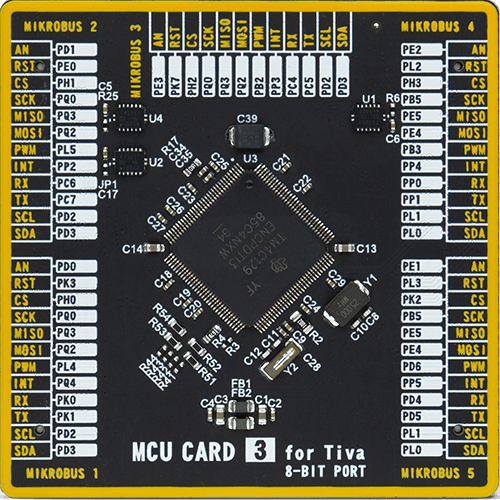
Type
8th Generation
Architecture
ARM Cortex-M4
MCU Memory (KB)
1024
Silicon Vendor
Texas Instruments
Pin count
128
RAM (Bytes)
262144
Used MCU Pins
mikroBUS™ mapper
Take a closer look
Click board™ Schematic
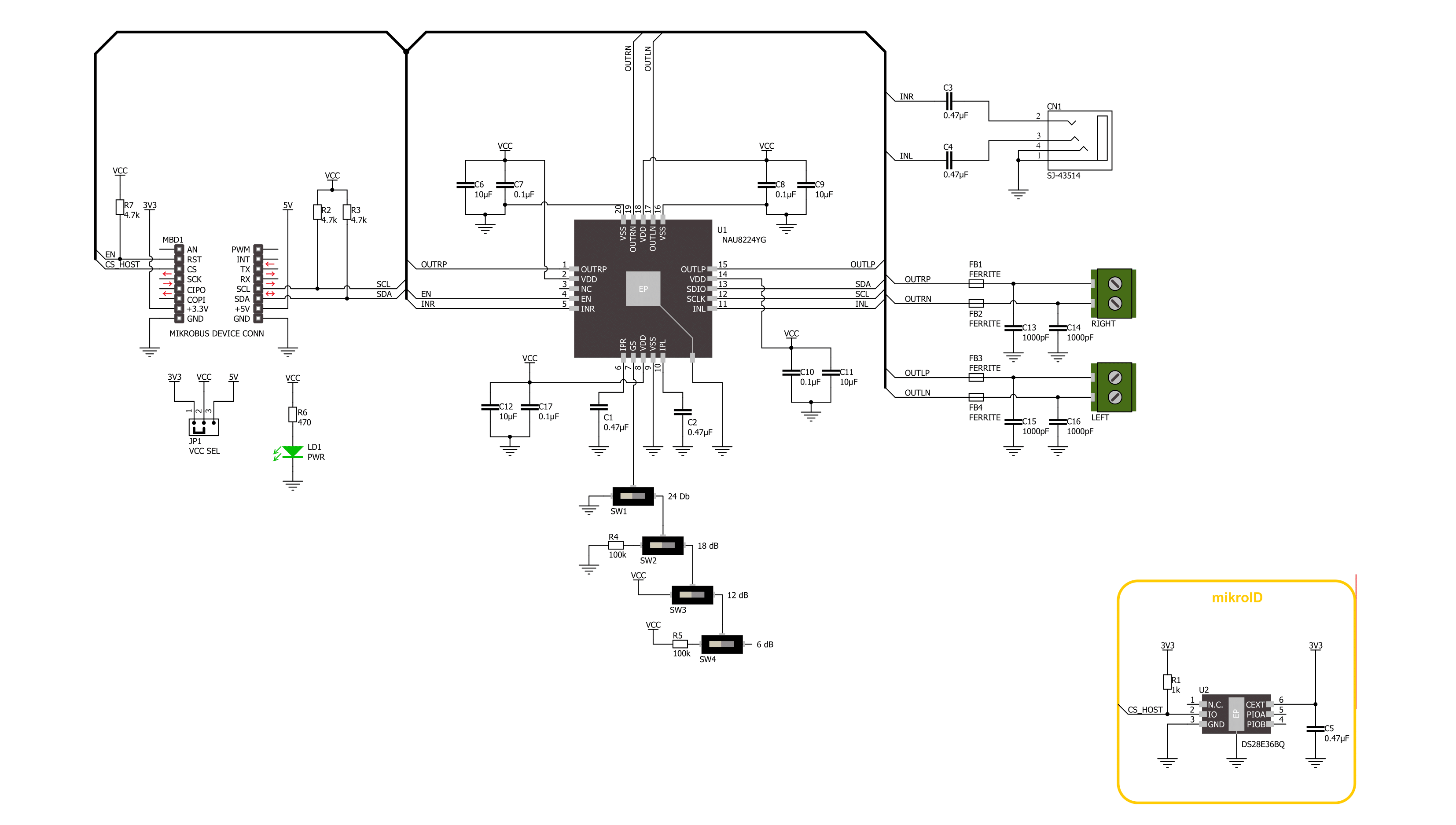
Step by step
Project assembly
Software Support
Library Description
This library contains API for AudioAMP 11 Click driver.
Key functions:
audioamp11_enable_deviceAudioAMP 11 enable device function.audioamp11_check_gainAudioAMP 11 check gain function.audioamp11_set_output_volume_levelAudioAMP 11 set output volume level function.
Open Source
Code example
The complete application code and a ready-to-use project are available through the NECTO Studio Package Manager for direct installation in the NECTO Studio. The application code can also be found on the MIKROE GitHub account.
/*!
* @file main.c
* @brief AudioAMP 11 Click example
*
* # Description
* This library contains API for the AudioAMP 11 Click driver.
* This demo application shows use of a AudioAMP 11 Click board™.
*
* The demo application is composed of two sections :
*
* ## Application Init
* Initialization of I2C module and log UART.
* After driver initialization the app set default settings,
* performs power-up sequence, sets the volume level to 0.
*
* ## Application Task
* This example demonstrates the use of the AudioAMP 11 Click board™.
* If GAIN SEL switches are set to 12dB, the app performs circles
* switching the volume from -20.5 dB to 12 dB.
* If the GAIN SEL switches are different, the app sets the volume level to 31 (maximum).
* Results are being sent to the UART Terminal, where you can track their changes.
*
* @author Nenad Filipovic
*
*/
#include "board.h"
#include "log.h"
#include "audioamp11.h"
static audioamp11_t audioamp11;
static log_t logger;
uint8_t vol_ctrl = AUDIOAMP11_GS_12dB_VOLCTRL_m20_5dB;
void application_init ( void )
{
log_cfg_t log_cfg; /**< Logger config object. */
audioamp11_cfg_t audioamp11_cfg; /**< Click config object. */
/**
* Logger initialization.
* Default baud rate: 115200
* Default log level: LOG_LEVEL_DEBUG
* @note If USB_UART_RX and USB_UART_TX
* are defined as HAL_PIN_NC, you will
* need to define them manually for log to work.
* See @b LOG_MAP_USB_UART macro definition for detailed explanation.
*/
LOG_MAP_USB_UART( log_cfg );
log_init( &logger, &log_cfg );
log_info( &logger, " Application Init " );
// Click initialization.
audioamp11_cfg_setup( &audioamp11_cfg );
AUDIOAMP11_MAP_MIKROBUS( audioamp11_cfg, MIKROBUS_1 );
if ( I2C_MASTER_ERROR == audioamp11_init( &audioamp11, &audioamp11_cfg ) )
{
log_error( &logger, " Communication init." );
for ( ; ; );
}
if ( AUDIOAMP11_ERROR == audioamp11_default_cfg ( &audioamp11 ) )
{
log_error( &logger, " Default configuration." );
for ( ; ; );
}
log_info( &logger, " Application Task " );
log_printf( &logger, "----------------------\r\n" );
Delay_ms ( 100 );
}
void application_task ( void )
{
uint8_t gain_level = 0;
uint8_t volume_level = 0;
audioamp11_check_gain( &audioamp11, &gain_level );
log_printf( &logger, " Gain set to %d dB\r\n", AUDIOAMP11_CALC_GAIN_CONFIG( gain_level ) );
if ( AUDIOAMP11_GAINDEC_12dB == gain_level )
{
float volume_table[ 32 ] = { OUTPUT_VOLUME_12dB };
audioamp11_set_output_volume_level( &audioamp11, vol_ctrl );
Delay_ms ( 100 );
if ( vol_ctrl > AUDIOAMP11_GS_12dB_VOLCTRL_12dB )
{
vol_ctrl--;
}
else
{
vol_ctrl = AUDIOAMP11_GS_12dB_VOLCTRL_m20_5dB;
}
audioamp11_get_output_volume_level( &audioamp11, &volume_level );
log_printf( &logger, " Volume set to %.1f dB\r\n", volume_table[ volume_level ] );
}
else
{
audioamp11_set_output_volume_level( &audioamp11, AUDIOAMP11_VOLUME_LEVEL_31 );
audioamp11_get_output_volume_level( &audioamp11, &volume_level );
}
log_printf( &logger, " Volume Level %d: ", ( uint16_t ) ( AUDIOAMP11_VOLUME_LEVEL_0 - volume_level ) );
for ( uint8_t n_cnt = 0; n_cnt < ( AUDIOAMP11_VOLUME_LEVEL_0 - volume_level ); n_cnt++ )
{
log_printf( &logger, "|" );
}
log_printf( &logger, "\r\n----------------------\r\n" );
Delay_ms ( 1000 );
}
int main ( void )
{
/* Do not remove this line or clock might not be set correctly. */
#ifdef PREINIT_SUPPORTED
preinit();
#endif
application_init( );
for ( ; ; )
{
application_task( );
}
return 0;
}
// ------------------------------------------------------------------------ END
Additional Support
Resources
Category:Amplifier
